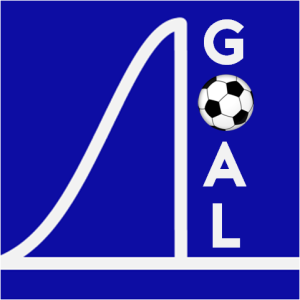What are adjusted goals?
Adjusted goals are my method of rating a team’s attack and defence. They use more information than just goals scored and conceded, also using “shots on target” and “shots”.
Why are adjusted goals better than actual goals scored or points won at rating a team’s strength?
The additional used data tends to reveal more about a team’s underlying performance than the actual scoreline – I’ve explained this here. Also, over the short-term actual goals scored are quite infrequent so they can be unreliable at rating a team.
How are adjusted goals calculated?
The calculation is simply:
Adjusted goals = 45.01%*Goals + 8.44%*”Shots on target” + 2.81%*Shots
For example, when Manchester City played Liverpool on 21/11/2015 they scored 1 goal from 3 shots on target and 11 shots. Liverpool scored 4 goals from 9 shots on target and 14 shots. So the adjusted goal calculation is:
Manchester City goals = 45.01%*1 + 8.44%*3 + 2.81%*11 = 1.01
Liverpool goals = 45.01%*4 + 8.44%*9 + 2.81%*14 = 2.95
How can you work-out a team’s attacking and defensive rating using adjusted goals?
I simply use a team’s average over a certain number of games. So for example, if you’re interested in understanding short-term form – you can take the average of a team’s adjusted goals scored and conceded over the previous (say) 6 league games to get an attack and defence rating.
I tend to use a long-term rating for most of my projections, because this is usually a better predictor of future performance (particularly in the English Premier League). For long-term rating I also use a team’s adjusted goals from the previous season.
For example if Arsenal’ s adjusted goals scored from last season were 1.87 per game, and their average this season after 11 games was 2.01 – I’d work out their long-term adjusted goals scored rating as:
(1.87*(38-11)+2.01*11)/38=1.91
So it’s weighted by number of games played (there are 38 games played by a team in a full Premier league season). The weighting of last season’s component reduces a more games are played. Long-term adjusted goals conceded are calculated in the same way.
How can you use adjusted goals?
I use them to create projections to predict future performance (e.g. league position or goals scored) and the outcome of individual matches, which I illustrate on this blog.
Can adjusted goals be used to determine value in bookmakers’ odds?
No – not on their own
Adjusted goal ratings are a good starting point for assessing value. But there is so much that they don’t take account of – like injuries, change of tactics, new signings, players transferring out, new manager, new owner, fixture congestion, off the field problems – further analysis is always needed.
Are “adjusted goals” the same as “expected goals”?
No.
The capture of sophisticated data from football matches has burgeoned over recent years, enabling the creation of fascinating models to estimate the quality of chances created and conceded. These “Expected Goals” models use multiple information about each chance (e.g. distance, angle and type of shot) to assess the expected goals scored by each team in a particular match.
Expected goals models represent a great progression in the analysis of football, and they have good predictive qualities. But their problems are they’re difficult to calculate and require multiple data inputs that aren’t freely available.
My adjusted goals model is far less sophisticated but uses simple data that can be taken from most match reports or from http://www.football-data.co.uk/ in Excel format.
Can adjusted goals be used for all leagues?
Yes – they can be used in leagues and countries where “shots on target” and “shots” data are available.
I’ve adjusted the factors used in each league so that the average adjusted goals per game are always around 2.68.
Where can you get data to calculate adjusted goals?
I use http://www.football-data.co.uk/ which allows full match data to be downloaded in Excel format.
Most match reports now also come with “shots on target “ and “shots” data.
More information
I’ve set out the rationale for adjusted goals here
